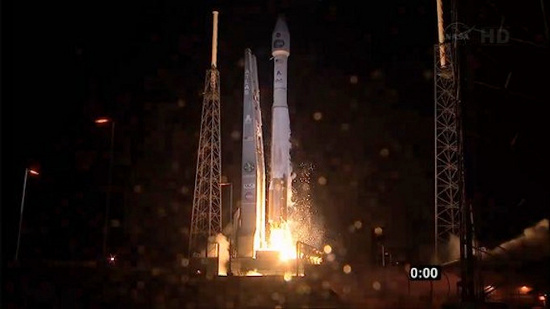NASA launches a new generation satellite
NASA has just launched a new generation transitional satellite into space, performing the task of upgrading the critical information network, connecting the space station and the Earth observation spacecraft.
This is the first launch in 2013 by the US Aerospace Agency.The TDRS-K satellite is introduced into space by Atlas 5 rocket launchers, at the launch pad at Cape Canaveral Space Center, Florida.

Atlas 5 rocket launchers carry TDRS-K satellite leaving the launch pad
at Cape Canaveral Space Center, Florida - (Photo: Space)
The TDRS-K satellite, orbiting the Earth about 35,888km, will work with a group of five satellites in the mission to help NASA and other space centers communicate with the spacecraft.
NASA's TDRS satellite network began in 1983. Before TDRS-K, 10 TDRS satellites were launched into space. Among them, five TDRS satellites are still active.
Scientists hope TDRS-K will operate for a minimum of 15 years. Badri Younes is working for NASA, adding that in the next few months, one of the satellites operating on the network will be retired.
The cost of implementing the mission of TDRS-K is about 350-400 million USD, not including missile fees.
The 8-meter TDRS-K satellite, weighing about 3,454kg, is expected to be separated from Atlas 5 missiles after taking 1 hour 46 minutes and takes two weeks to reach the expected trajectory. After going into operation it will be renamed to TDRS-11.
- NASA launches the most modern weather satellite to date
- Russia spoiled the satellite again
- US launches new generation weather satellite
- US launches satellite to measure emissions
- Huge spy satellite
- NASA prepares to launch a new generation satellite tracking Earth's melting ice
- NASA launches satellites to explore the mysterious region of the atmosphere
- US launches satellite tracking climate change
- Bolivia launches satellites in China
- Rescue agents for NASA
- NASA is about to launch a new generation earth observation satellite
- Switzerland launched a satellite to look after space in 2018
 Van Allen's belt and evidence that the Apollo 11 mission to the Moon was myth
Van Allen's belt and evidence that the Apollo 11 mission to the Moon was myth The levels of civilization in the universe (Kardashev scale)
The levels of civilization in the universe (Kardashev scale) Today Mars, the sun and the Earth are aligned
Today Mars, the sun and the Earth are aligned The Amazon owner announced a secret plan to build a space base for thousands of people
The Amazon owner announced a secret plan to build a space base for thousands of people